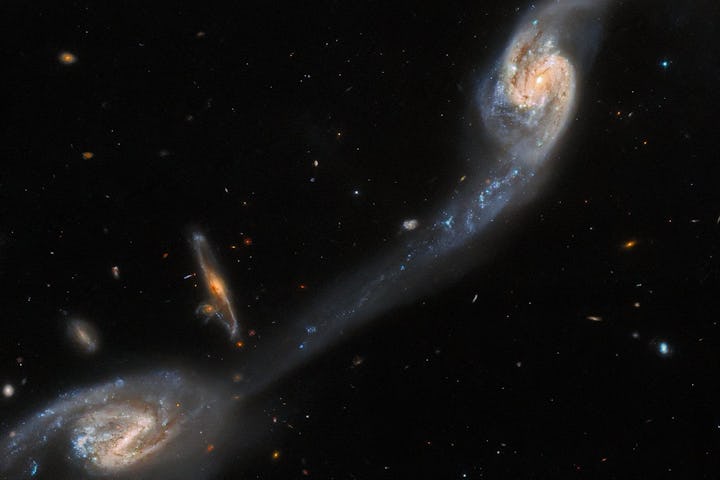Astounding Hubble Video Shows Spiral Galaxies Connected By An Intergalactic Bridge
The latest video from Hubble gives a unique look at a spiral of galaxies 200 light-years away.

We’ve seen a lot of gorgeous photos recently from the new James Webb Space Telescope (JWST), but we can’t sleep on the oldie but goodie Hubble Telescope, because it’s still capturing incredible images. The latest photo gives us a unique look at a spiral of galaxies that are connected by an intergalactic bridge, and it’s stunning.
Explaining the new photo of the spiral galaxies with an intergalactic bridge like you’re 5:
On November 3, the official Twitter account for the European Space Agency’s feed for the Hubble Telescope shared a video of two galaxies in the galactic triplet Arp 248 — known as Wild's Triplet — which is 200 million light-years from Earth.
In the video, you can see two swirls of galaxies. They look small, but they’re each a massive collection of billions of stars, their solar system, dust, and gas — like our Milky Way. Between the two galaxies, there’s a cloud-looking ribbon that’s connecting the two, and while it looks like this whole section is all one, it’s not.
The ribbon section is an intergalactic bridge called a tidal tail. It’s been seen in space before and is made up of a stream of dust and stars formed due to the gravitational pull of the two galaxies, the European Space Agency explains.
“This observation comes from a project which delves into two galleries of weird and wonderful galaxies: A Catalogue of Southern Peculiar Galaxies and Associations,” the agency writes.
“Each collection contains a menagerie of spectacularly peculiar galaxies, including interacting galaxies such as Arp 248 and one- or three-armed spiral galaxies, galaxies with shell-like structures, and a variety of other space oddities.”
For more information on the newly released video, be sure to check out the European Space Agency.
This article was originally published on